Inversion of Wheat Leaf Area Index by Multivariate Red-Edge Spectral Vegetation Index
Abstract
1. Introduction
2. Materials and Methods
2.1. Materials
2.1.1. Study Area
2.1.2. Field LAI Measurements
2.1.3. Sentinel-2 MSI Data and Pre-Process
2.2. Methods
2.2.1. Selection of Red-Edge Spectral Vegetation Index
2.2.2. LAI Inversion Accuracy Assessment
3. Results
3.1. Correlation Analysis
3.2. Red-Edge Spectral Vegetation Index and Measured LAI Fitting Analysis
3.3. Spectral Saturation Sensitivity Analysis
3.4. Model Verification
3.5. LAI Inversion Distribution Mapping
4. Discussion
5. Conclusions
- (1)
- The univariate red-edge spectral vegetation index has a certain correlation with the measured LAI of winter wheat at the booting stage, but weaker than the multivariate red-edge spectral vegetation index.
- (2)
- The fitting accuracy of the multivariate red-edge spectral vegetation index was higher than that of the univariate red-edge spectral vegetation index, and the more fitting variables, the better the correlation, the higher the inversion precision, the better the inversion effect. Among them, NDSI1 + NDSI2 + NDSI3 + TCARI/OSAVI + MCARI + MTCI + TCARI multivariate red-edge spectral vegetation index and the measured LAI fitting accuracy of the winter wheat were the highest, which proved that the model could meet the requirements of LAI inversion accuracy of winter wheat.
- (3)
- With the increase in LAI, the spectral saturation increase rate of multivariate red-edge spectral vegetation index was slower than that of univariate red-edge spectral vegetation index, because the combination of red-edge band delayed the spectral saturation effect to some extent.
- (4)
- The red-edge spectral vegetation index constructed by the red-edge band in the Sentinel-2 remote sensing image had a strong inversion ability for winter wheat LAI at the booting stage.
Author Contributions
Funding
Institutional Review Board Statement
Informed Consent Statement
Data Availability Statement
Acknowledgments
Conflicts of Interest
References
- Zhao, J.; Huang, W.J.; Zhang, Y.H.; Jing, S.Y. Leaf area index inversion method for winter wheat at different growth stages. Spectrosc. Spectr. Anal. 2013, 23, 2246–2252. [Google Scholar]
- Wei, X.; Gu, X.; Meng, Q.; Yu, T.; Zhou, X.; Wei, Z.; Jia, K.; Wang, C. Leaf Area Index Estimation Using Chinese GF-1 Wide Field View Data in an Agriculture Region. Sensors 2017, 17, 1593. [Google Scholar] [CrossRef] [PubMed]
- González-Sanpedro, M.; Le Toan, T.; Moreno, J.; Kergoat, L.; Rubio, E. Seasonal Variations of Leaf Area Index of Agricultural Fields Retrieved from Landsat Data. Remote Sens. Environ. 2008, 112, 810–824. [Google Scholar] [CrossRef]
- Yang, X.B.; Wang, C.; Pan, F. Retrieving leaf area index in discontinuous forest using ICESat/GLAS full-waveform data based on gap fraction model. ISPRS J. Photogramm. Remote Sens. 2019, 148, 54–62. [Google Scholar] [CrossRef]
- Govaerts, Y.M.; Verstraete, M.M.; Pinty, B.; Gobron, N. Designing Optimal Spectral Indices: A Feasibility and Proof of Concept Study. Int. J. Remote Sens. 1999, 20, 1853–1873. [Google Scholar] [CrossRef]
- Biswas, A.; Chakraborty, A.; Jana, N.R. Nitrogen and Fluorine Codoped, Colloidal TiO2 Nanoparticle: Tunable Doping, Large Red-Shifted Band Edge, Visible Light Induced Photocatalysis, and Cell Death. ACS Appl. Mater. Interfaces 2018, 10, 1976–1986. [Google Scholar] [CrossRef]
- Hansen, P.M.; Schjoerring, J.K. Reflectance measurement of canopy biomass and nitrogen statue in wheat crops usingnormalized difference vegetation indices and partial least squares regression. Remote Sens. Environ. 2003, 86, 542–553. [Google Scholar] [CrossRef]
- Anne, M.S.; Gaetan, B.; Philippe, M.T. A comparison of NDVI and MTVI2 for estimating LAI using CHRIS imagery: A case study in wheat. Can. J. Remote Sens. 2008, 6, 539–548. [Google Scholar]
- Darvishzadeh, R.; Skidmore, A.; Schlerf, M.; Atzberger, C.; Corsi, F.; Cho, M. LAI and chlorophyll estimation for a heterogeneous grassland using hyperspectral measurements. ISPRS J. Photogramm. Remote Sens. 2008, 63, 409–426. [Google Scholar] [CrossRef]
- Herrmann, I.; Pimstein, A.; Karnieli, A.; Cohen, Y.; Alchanatis, V.; Bonfil, D.J. LAI assessment of wheat and potato crops by VEN mu S and Sentinel-2 bands. Remote Sens. Environ. 2011, 115, 2141–2151. [Google Scholar] [CrossRef]
- Nahuel, R.P.; Yared, A.; Juan, D. Mid-Season High-Resolution Satellite Imagery for Forecasting Site-Specific Corn Yield. Remote Sens. 2016, 10, 848. [Google Scholar]
- Cao, Z.; Cheng, T.; Ma, X.; Tian, Y.; Zhu, Y.; Yao, X.; Chen, Q.; Liu, S.; Guo, Z.; Zhen, Q.; et al. A new three-band spectral index for mitigating the saturation in the estimation of leaf area index in wheat. Int. J. Remote Sens. 2017, 13, 3865–3885. [Google Scholar] [CrossRef]
- Su, W.; Hou, N.; Li, Q.; Zhang, M.Z.; Zhao, X.F.; Jiang, K.P. Retrieving Leaf Area Index of Corn Canopy Based on Sentinel-2 Remote Sensing Image. Trans. Chin. Soc. Agric. Mach. 2018, 49, 151–156. [Google Scholar]
- Xie, Q.Y. Research on Leaf Area Index Retrieve Methods Based on the Red Edge Bands from Multi-Platform Remote Sensing Data; University of Chinese Academy of Sciences (Institute of Remote Sensing and Digital Earth Research, Chinese Academy of Sciences): Beijing, China, 2017. [Google Scholar]
- Zheng, Y.; Wu, B.F.; Zhang, M. Estimating the above ground biomass of winter wheat using the Sentinel-2 data. J. Remote Sens. 2017, 21, 318–328. [Google Scholar]
- Gao, X. Nitrogen Nutrition Monitoring of Potato Plants Based on Red Edge Position; Inner Mongolia Agricultural University: Hohhot, China, 2018. [Google Scholar]
- West, H.; Quinn, N.; Horswell, M. Assessing Vegetation Response to Soil Moisture Fluctuation under Extreme Drought Using Sentinel-2. Water 2018, 10, 838. [Google Scholar] [CrossRef]
- Kaplan, G.; Avdan, U. Object-based water body extraction model using Sentinel-2 satellite imagery. Eur. J. Remote Sens. 2017, 1, 137–143. [Google Scholar] [CrossRef]
- Sims, D.A.; Gamon, J.A. Relationships between leaf pigment content and spectral reflectance across a wide range of species, leaf structures and developmental stages. Remote Sens. Environ. 2002, 81, 337–354. [Google Scholar] [CrossRef]
- Stagakis, S.; Markos, N.; Sykioti, O.; Kyparissis, A. Tracking seasonal changes of leaf and canopy light use efficiency in a Phlomis fruticosa Mediterranean ecosystem using field measurements and multi-angular satellite hyperspectral imagery. ISPRS J. Photogramm. Remote Sens. 2014, 97, 138–151. [Google Scholar] [CrossRef]
- Yaser, S.; Benoît, S.; Brigitte, L. Mapping boreal forest biomass from a SRTM and TanDEM-X based on canopy height model and Landsat spectral indices. Int. J. Appl. Earth Obs. Geoinf. 2018, 68, 202–213. [Google Scholar]
- Li, F.; Mistele, B.; Hu, Y.; Chen, X.; Schmidhalter, U. Comparing hyperspectral index optimization algorithms to estimate aerial N uptake using multi-temporal winter wheat datasets from contrasting climatic and geographic zones in China and Germany. Agric. For. Meteorol. 2013, 180, 44–57. [Google Scholar] [CrossRef]
- Daughtry, C.; Walthall, C.; Kim, M.; de Colstoun, E.B.; McMurtrey, J.E., III. Estimating corn leaf chlorophyll concentration from leaf and canopy reflectance. Remote Sens. Environ. 2000, 74, 229–239. [Google Scholar] [CrossRef]
- Chuchotirot, M.; Sutanthavibul, A. Prediction of adverse perinatal outcome by umbilical artery to middle cerebral artery resistance index ratio in pregnancies complicated by hypertensive disorder. Siriraj Med. J. 2002, 54, 611–616. [Google Scholar]
- Foody, G.M.; Dash, J. Estimating the relative abundance of C3 and C4 grasses in the Great Plains from multi-temporal MTCI data: Issues of compositing period and International. J. Remote Sens. 2010, 31, 351–362. [Google Scholar] [CrossRef]
- Pastor-Guzman, J.; Atkinson, P.M.; Dash, J.; Rioja-Nieto, R. Spatiotemporal Variation in Mangrove Chlorophyll Concentration Using Landsat 8. Remote Sens. 2015, 7, 14530–14558. [Google Scholar] [CrossRef]
- Zhang, Y.; Han, W.T.; Niu, X.T.; Li, G. Maize Crop Coefficient Estimated from UAV-Measured Multispectral Vegetation Indices. Sensors 2019, 19, 5250. [Google Scholar] [CrossRef]
- Vincini, M. Comparing narrow and broad-band vegetation indices to estimate leaf chlorophyll content in planophile crop canopies. Precis. Agric. 2011, 12, 334–344. [Google Scholar] [CrossRef]
- Hess, K. Water level simulation in bays by spatial interpolation of tidal constituents, residual water levels, and datums. Cont. Shelf Res. 2003, 23, 395–414. [Google Scholar] [CrossRef]
- Zhang, J.L. Remote Sensing Monitoring of Winter Wheat Growth Potential Based on Comprehensive Growth Potential Parameters; Xian University of Science and Technology: Xian, China, 2018. [Google Scholar]
- Zarco-Tejada, P.J.; Miller, J.R.; Morales, A. Hyperspectral indices and model simulation for chlorophyll estimation in open-canopy tree crops. Remote Sens. Environ. 2004, 90, 463–476. [Google Scholar] [CrossRef]

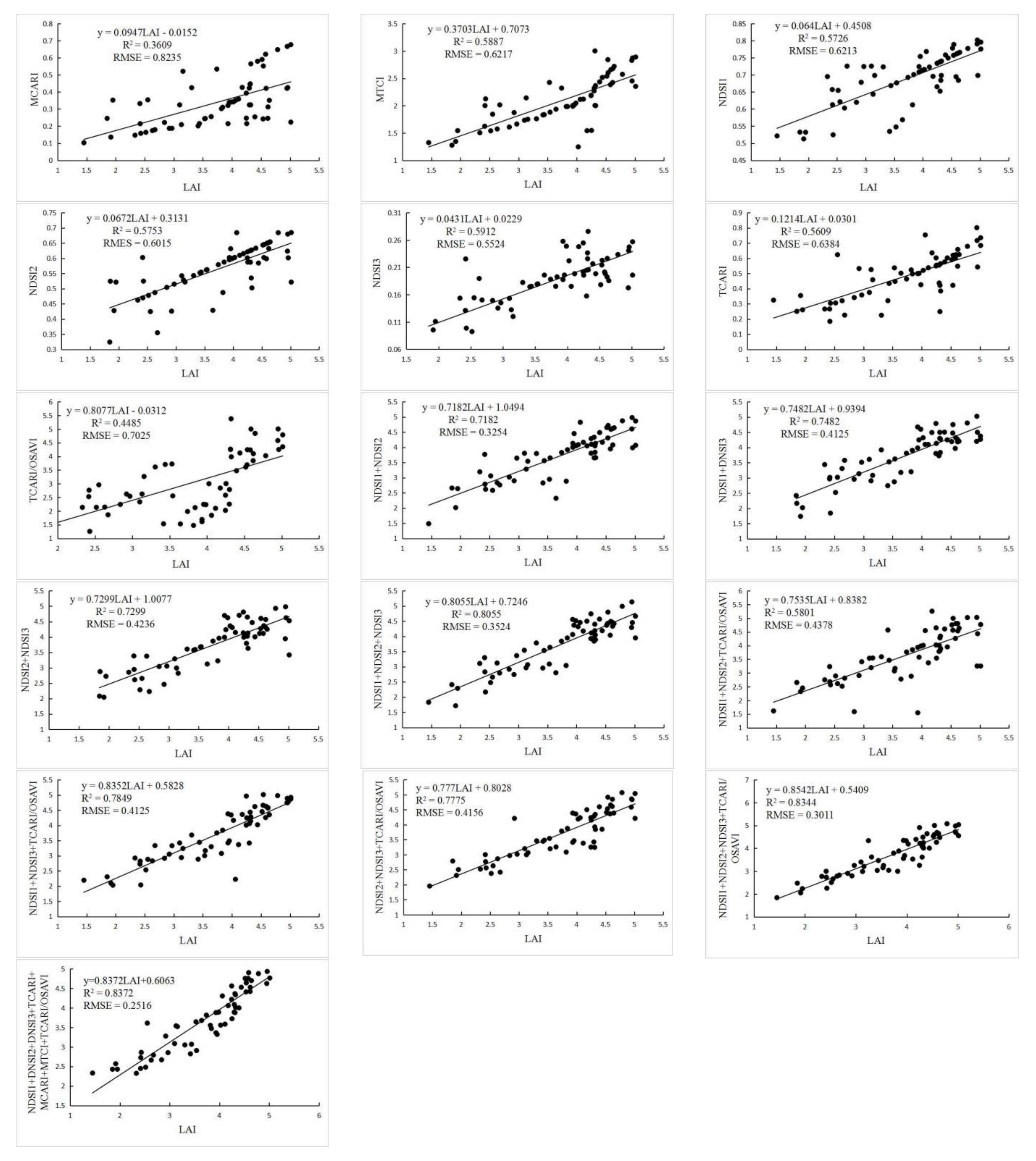
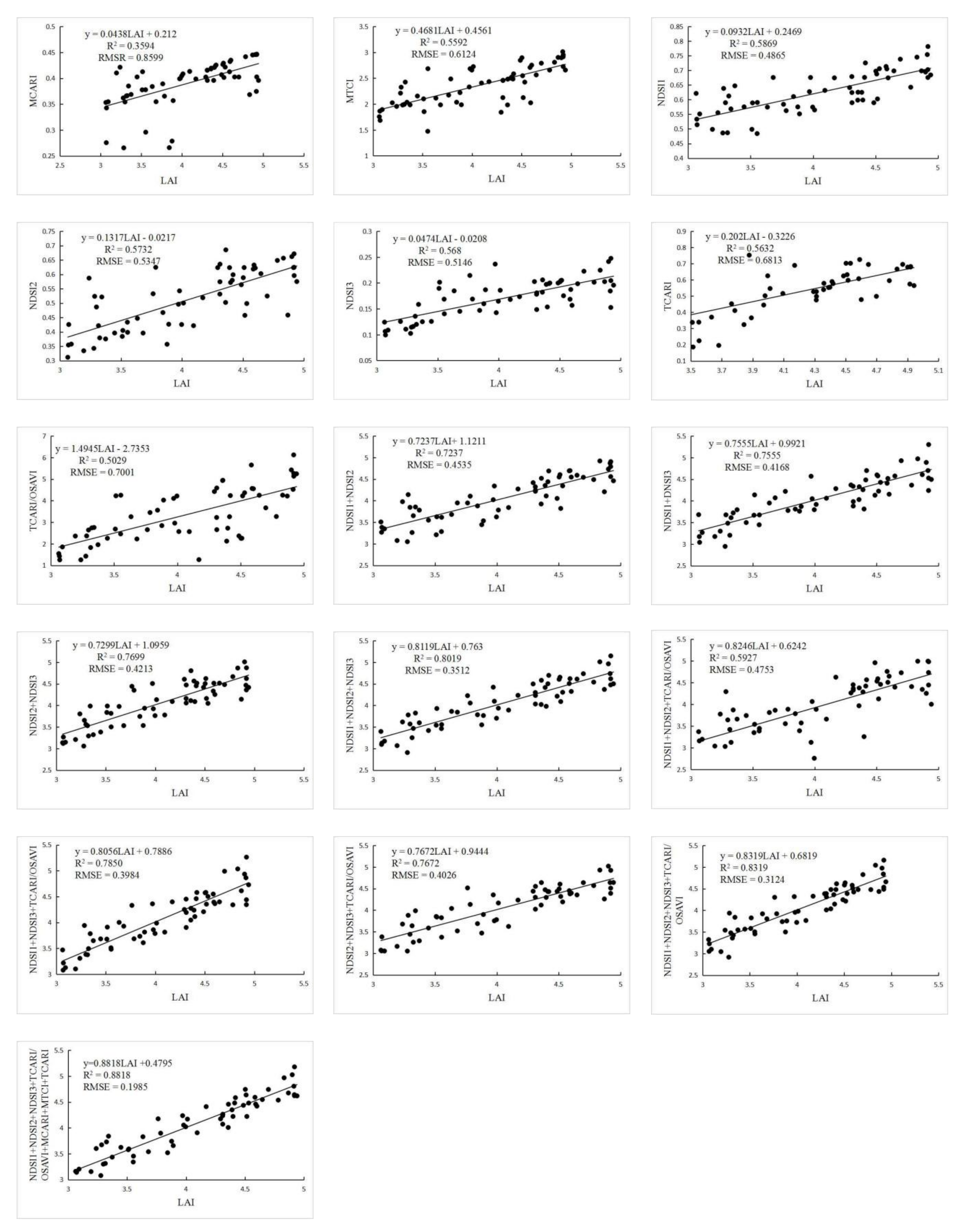
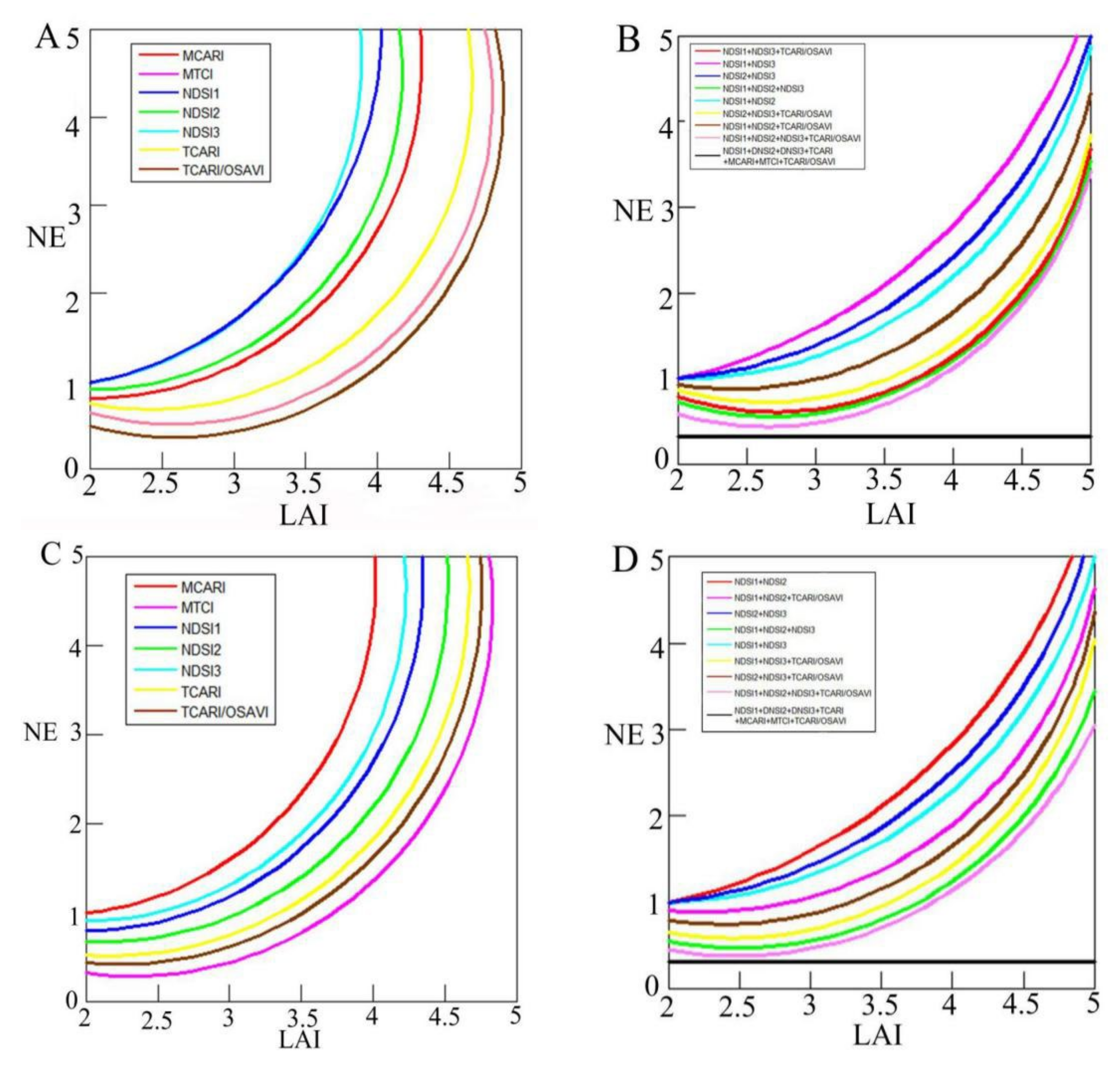
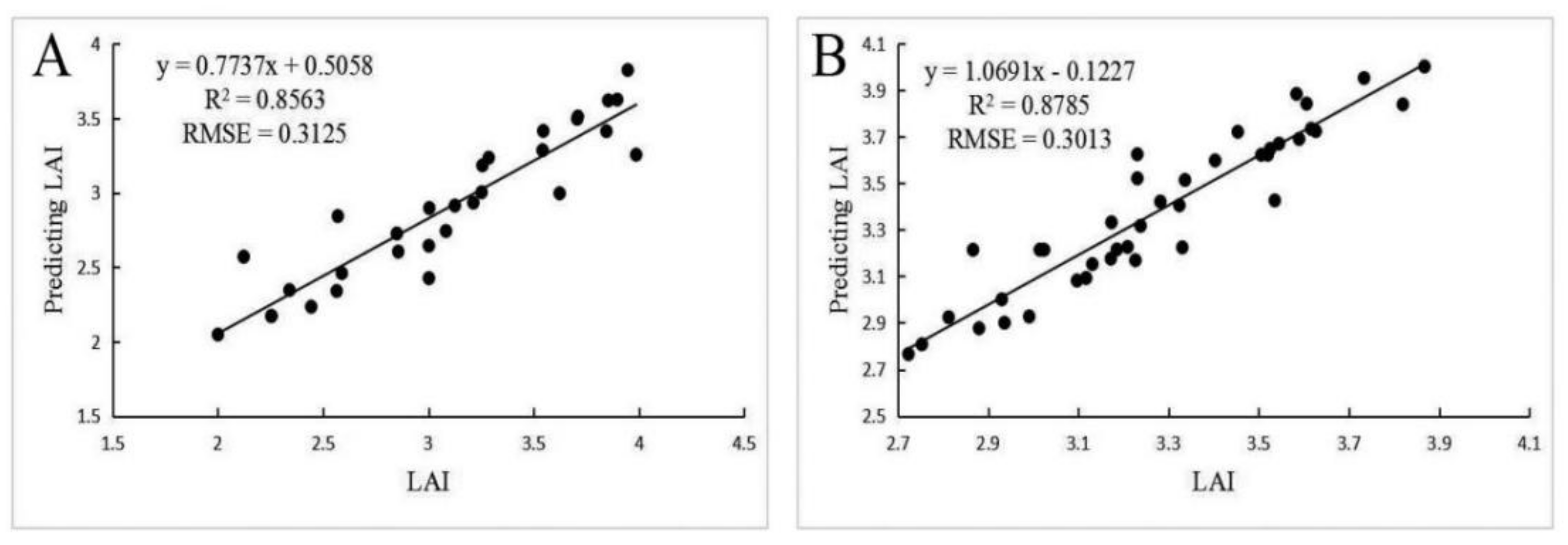
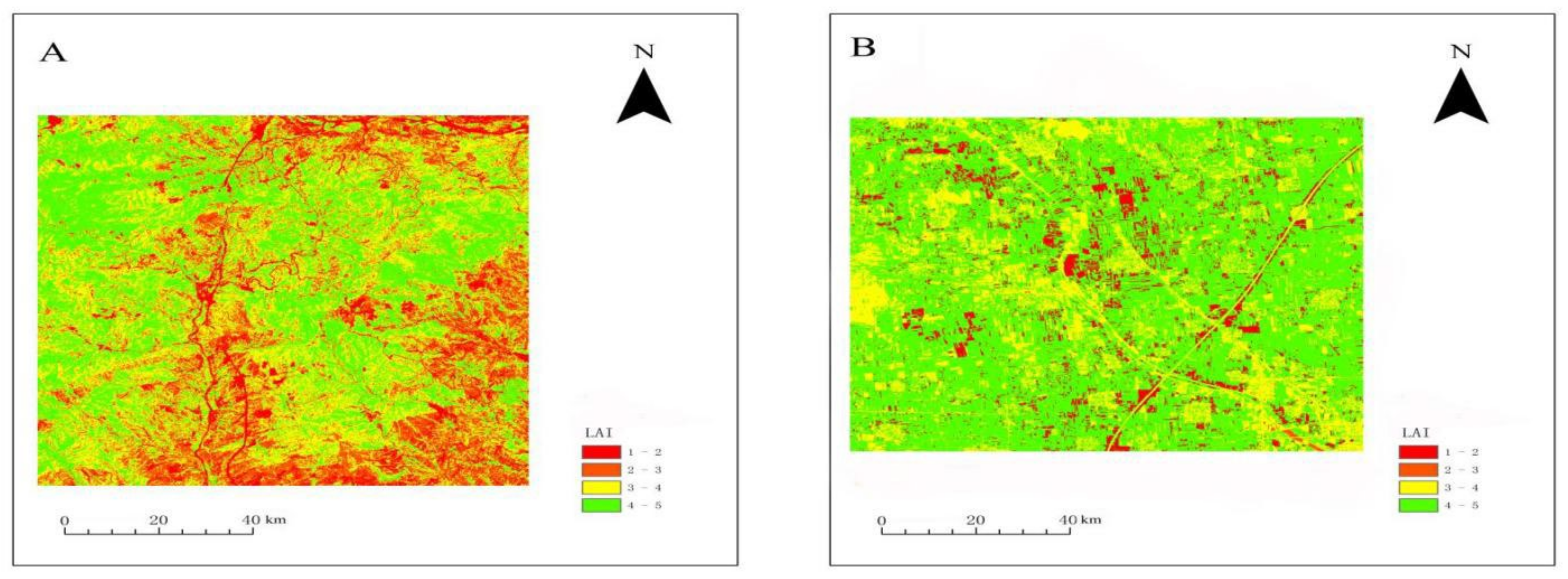
| Variable Model | Red-Edge Spectral Vegetation Index | Formula | References |
|---|---|---|---|
| Univariate model | NDSI1 | (R783 − R740)/(R783 + R740) | [19,20] |
| NDSI2 | (R740 − R705)/(R740 + R705) | [21] | |
| NDSI3 | (R783 − R705)/(R783 − R705) | [22] | |
| MCARI | [(R705 − R665) − 0.2(R705 − R560)] × (R705/R665) | [23,24] | |
| MTCI | (R665 − R705)/(R783 + R665) | [25,26] | |
| TCARI | 3[(R783 − R665) − 0.2(R705 − R560)(R705/R665)] | [27,28,29] | |
| TCARI/OSAVI | 3[(R783 − R665) − 0.2(R705 − R560)(R705/R665)]/(1 + 0.16)(R842 − R665)(R842 + R665 + 0.16) | [30,31] | |
| Multivariate model | NDSI1 + NDSI2 | y = −3.138 + 5.4047NDSI1 + 5.5653NDSI2 | |
| NDSI2 + NDSI3 | y = −1.333 + 5.500NDSI2 + 10.7176DNSI3 | ||
| NDSI1 + NDSI3 | y = −2.2846 + 5.7565NDSI1 + 11.1507DNSI3 | ||
| NDSI1 + NDSI2 + NDSI3 | y = −2.906 + 4.2064DNSI1 + 3.8653DNSI2 + 8.4752DNSI3 | ||
| NDSI1 + NDSI2 + TCARI/OSAVI | y = 1.974 + 3.5074NDSI1 + 3.518NDSI2 + 0.3093TCARI/OSAVI | ||
| NDSI1 + NDSI3 + TCARI/OSAVI | y = −1.561 + 3.923NDSI1 + 7.349DNSI3 + 0.2945TCARI/OSAVI | ||
| NDSI2 + NDSI3 + TCARI/OSAVI | y = −0.911 + 3.71DNSI2 + 6.9515DNSI3 + 0.3010TCARI/OSAVI | ||
| NDSI1 + NDSI2 + NDSI3 + TCARI/OSAVI | y = −2.0267 + 3.0019NDSI1 + 2.68NDSI2 + 6.0964NDSI3 + 0.2512TCARI/OSAVI | ||
| NDSI1 + NDSI2 + NDSI3 + TCARI/OSAVI + MCARI + MTCI + TCARI | y = 0.3475 + 1.0404NDSI1 + 0.6044NDSI2 − 0.4747NDSI3 − 0.0868TCARI + 2.1645MCARI + 1.8548MTCI + 0.2096TCARI/OSAVI |
| Red-Edge Spectral Vegetation Index | Correlation Coefficient | |
|---|---|---|
| Sanmenxia County | Xinxiang County | |
| NDSI1 | 0.7567 | 0.7660 |
| NDSI2 | 0.7585 | 0.7571 |
| NDSI3 | 0.7689 | 0.7536 |
| MCARI | 0.6007 | 0.5994 |
| MTCI | 0.7672 | 0.7478 |
| TCARI | 0.7487 | 0.7504 |
| TCARI/OSAVI | 0.6697 | 0.7091 |
| NDSI1 + NDSI2 | 0.8475 | 0.8507 |
| NDSI1 + NDSI3 | 0.8650 | 0.8692 |
| NDSI2 + NDSI3 | 0.8543 | 0.8774 |
| NDSI1 + NDSI2 + NDSI3 | 0.8974 | 0.8955 |
| NDSI1 + NDSI2 + TCARI/OSAVI | 0.7701 | 0.7694 |
| NDSI1 + NDSI3 + TCARI/OSAVI | 0.8859 | 0.8860 |
| NDSI2 + NDSI3 + TCARI/OSAVI | 0.8817 | 0.8758 |
| NDSI1 + NDSI2 + NDSI3 + TCARI/OSAVI | 0.9134 | 0.9120 |
| NDSI1 + NDSI2 + NDSI3 + TCARI/OSAVI + MCARI + MTCI + TCARI | 0.9149 | 0.9390 |
Publisher’s Note: MDPI stays neutral with regard to jurisdictional claims in published maps and institutional affiliations. |
© 2022 by the authors. Licensee MDPI, Basel, Switzerland. This article is an open access article distributed under the terms and conditions of the Creative Commons Attribution (CC BY) license (https://creativecommons.org/licenses/by/4.0/).
Share and Cite
Wang, X.; Cai, G.; Lu, X.; Yang, Z.; Zhang, X.; Zhang, Q. Inversion of Wheat Leaf Area Index by Multivariate Red-Edge Spectral Vegetation Index. Sustainability 2022, 14, 15875. https://doi.org/10.3390/su142315875
Wang X, Cai G, Lu X, Yang Z, Zhang X, Zhang Q. Inversion of Wheat Leaf Area Index by Multivariate Red-Edge Spectral Vegetation Index. Sustainability. 2022; 14(23):15875. https://doi.org/10.3390/su142315875
Chicago/Turabian StyleWang, Xiaoxuan, Guosheng Cai, Xiaoping Lu, Zenan Yang, Xiangjun Zhang, and Qinggang Zhang. 2022. "Inversion of Wheat Leaf Area Index by Multivariate Red-Edge Spectral Vegetation Index" Sustainability 14, no. 23: 15875. https://doi.org/10.3390/su142315875
APA StyleWang, X., Cai, G., Lu, X., Yang, Z., Zhang, X., & Zhang, Q. (2022). Inversion of Wheat Leaf Area Index by Multivariate Red-Edge Spectral Vegetation Index. Sustainability, 14(23), 15875. https://doi.org/10.3390/su142315875






